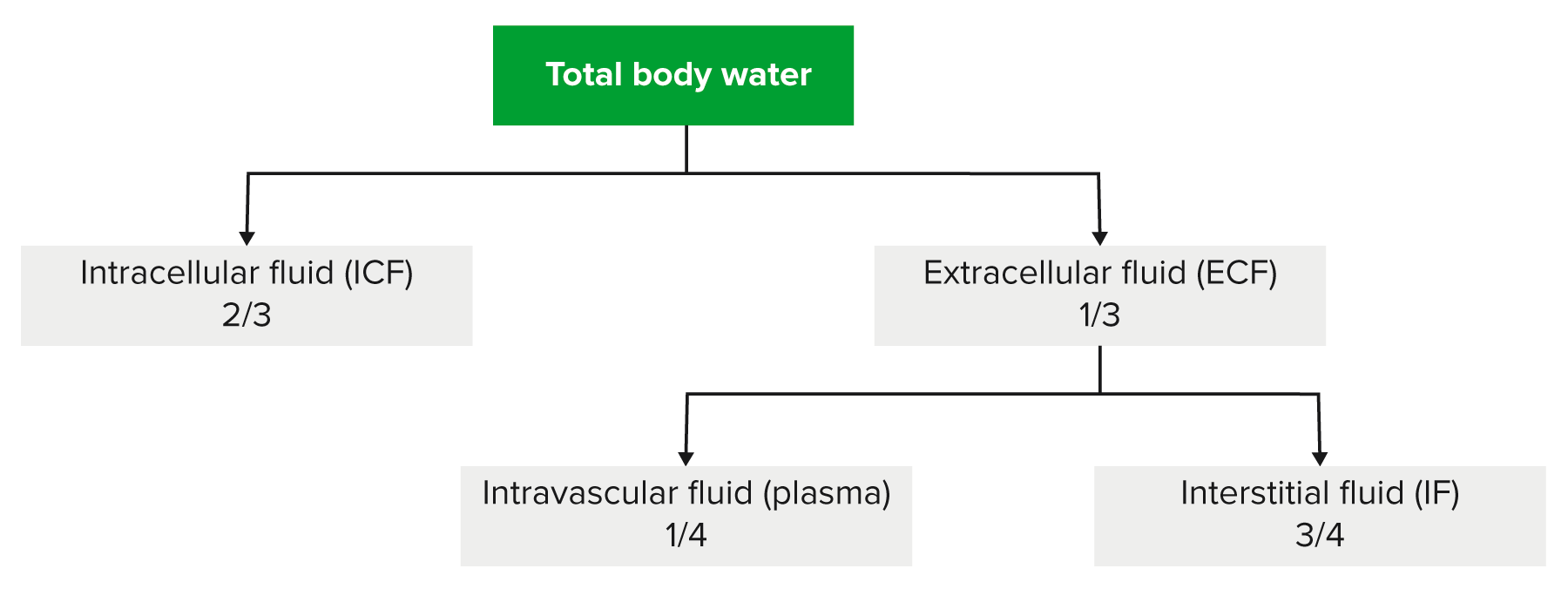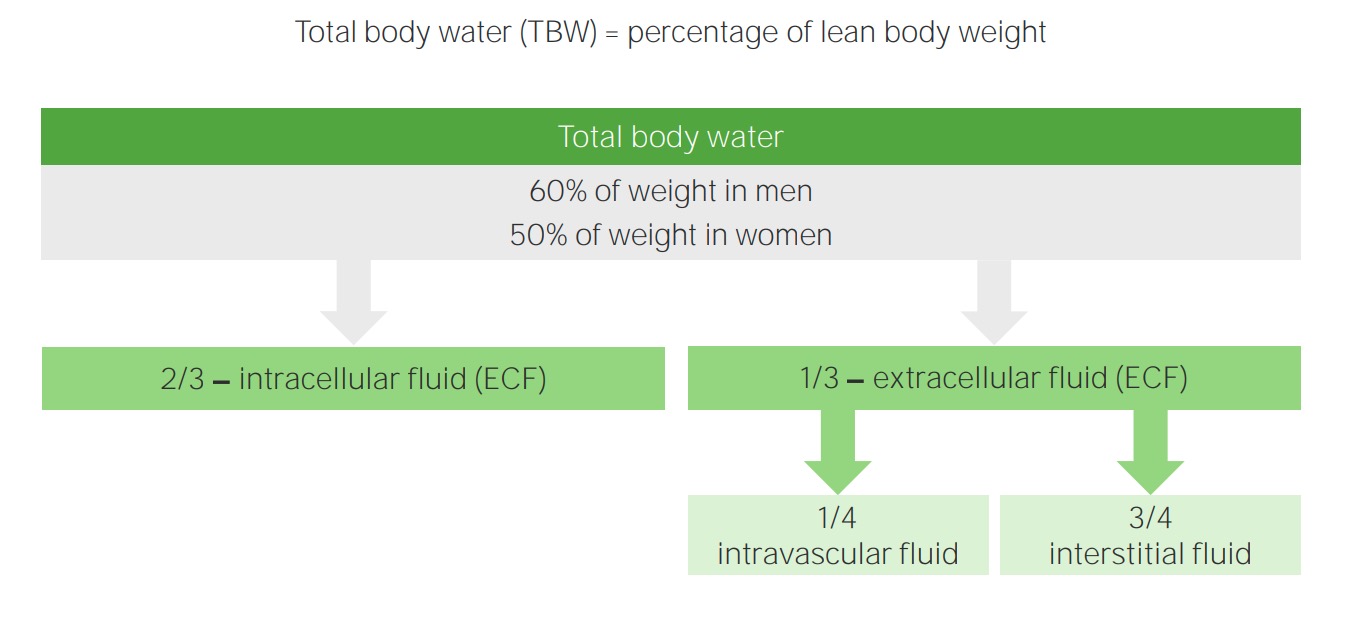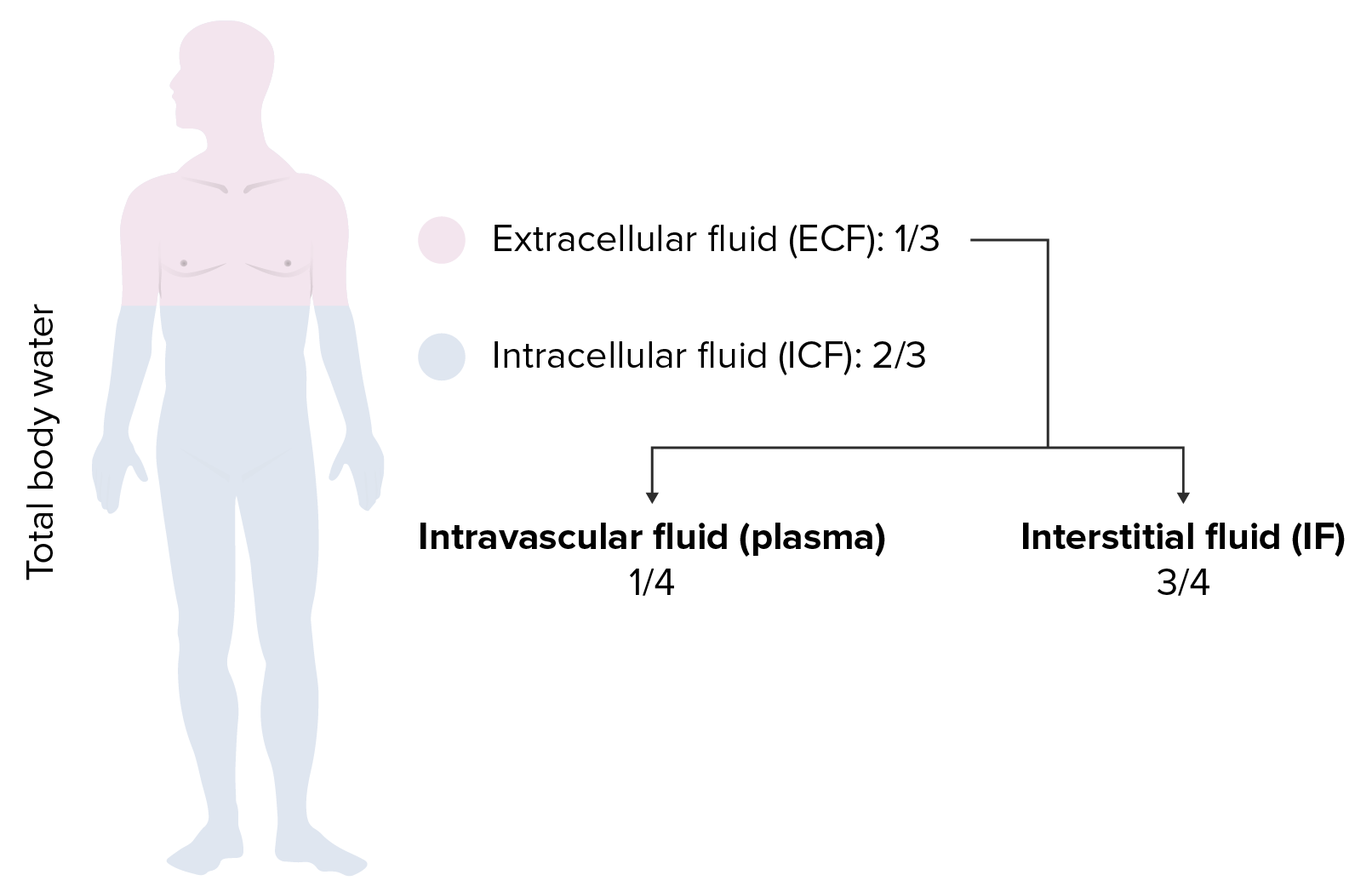Playlist
Show Playlist
Hide Playlist
Hypertonic Fluid Disorders
-
Slides Dehydration IntegratedRenalPathology.pdf
-
Reference List Pathology.pdf
-
Download Lecture Overview
00:00 Hypertonic fluid disorders is where we are now. Once we’ve gone through this discussion, we have completed our entire lecture series of all water and sodium pathophysiologic conditions. 00:15 So hypertonic, much, much more straightforward and for the most part comes into play in various differentials. With hypertonic fluid disorders, you can expect there to be once again, osmotic gradient. When you say hypertonicity, because of increased plasma osmolarity that we shall see in all of these conditions, that there’s going to be a shift of the fluid from the ICF, hence contraction, into the ECF, thus ECF expansion. As a general rule, in the previous discussion with hypotonic fluid disorders, in all the fluid, not all, but fluid is then moving into the ICF. With hypertonic gain of sodium, what does this mean to you? Let’s begin with the ratio. With the ratio here, you'll find that the total body sodium in magnitude has increased much greater than the total body water. What then happens to the ratio? It’s increased. 01:18 What does that ratio tell you? Plasma osmolarity has increased. Okay? If the plasma osmolarity has increased, then you can expect the fluid then to be pulled out of your ICF. 01:30 You find ECF volume expansion and you find ICF volume contraction. 01:35 Pitting edema, examples here would be infusion of well, NaHCO3 or sodium bicarbonate type of antibiotics. So in these cases, you would then expect there to be, now remember, this is not going to be normal saline. Be careful because if this is normal saline and being infused, you wouldn't be causing any type of tonicity changes. In our previous discussion, where did normal saline come into play? It was isotonic change, isotonic change. 02:13 The only thing that you find was an ECF volume expansion. That is not the case here. 02:17 Here, you actually are finding solute being introduced into the ECF, hence, the pulling of water out of the ICF. Let's move on, loss of pure water. Well, this would be something like what condition, loss of pure water. How about diabetes insipidus? In diabetes insipidus, you’d be losing pure water because well, either ADH is not being produced, that would be central diabetes insipidus, or the ADH is not properly working on its receptor. 02:49 That's called nephrogenic diabetes insipidus, isn't it? The ultimate consequence of both of those causes of diabetes insipidus will be, take a look at the ratio, the denominator is magnitude-wise massive loss of total body water. What then happens to your plasma osmolarity? Increase, so you have an increase in plasma osmolarity. What is it going to do to the ICF? It is then going to pull it out. So now, things get really interesting here. I want you to compare this to the previous discussion of your sodium bicarb or sodium chloride type of containing antibiotics and focus upon the ECF for a second here. Let me ask you a question. Close your eyes. 03:39 If you're only taking sodium-containing antibiotics or pills, then what happens to ECF? You're increasing plasma osmolarity, aren’t you? That's the overall theme for this discussion. 03:52 You're going to pull water out. What then happens to ECF volume in sodium-containing antibiotics, increase ECF volume. Stop there. This is diabetes insipidus. So now, you’re peeing, you’re peeing, you’re peeing, you’re peeing. In other words, you're urinating. Sorry, a little crass. 04:11 You're urinating excessively. It's pure water that you're losing. Plasma osmolarity is increased. 04:18 Dr. Raj, the water is being pulled out of the ICF. Why is my ECF not expanding? Have you fixed the problem? Not yet. So, even if you’re pulling the water out, you're continuing to do what? Ah, urinate. Do you understand now, what do you find your ECF contraction? It is going to be decreased but it will be mild because there has been no loss of sodium. That’s very, very important for you to understand. So even though that you’re losing pure water, the fact that you're not losing sodium is amazing. Take a look at that ratio. 04:53 The sodium remains the same. The only thing that you're losing is pure water. What does that mean to you clinically? Be careful. Listen. So here, if you’re retaining your sodium and you’re losing pure water, normal skin turgor, fascinating. That means that you will not find, even though the patient has volume depletion, the skin, you don't find there to be decreased turgor. Fascinating. 05:18 Examples, diabetes insipidus, central or nephrogenic. Obviously, later discussions, we'll talk about how to differentiate between the two and that you should be quite familiar. 05:30 The other big one is insensible water loss. Meaning to say, high fevers in which literally pure water not lost in urine but is being lost in the form of evaporation. 05:43 Now, hypotonic loss of sodium. Now, as we had just done earlier with hypotonic fluid disorders, hypotonic fluid disorders and in that particular case, I talked about congestive heart failure and cirrhosis and nephrotic in which there was hypotonic gain of sodium. Interesting. 06:06 In hypertonic fluid disorder, we're going to have hypotonic loss of sodium. 06:11 So to begin with, what do you want this ratio to do in this theme of hypertonic fluid disorder? Obviously, you want this to then increase. If you find sodium to be decreased in total body water and the magnitude of total body water is a greater loss, you then call this hypotonic loss of sodium. 06:33 You’ll see the clinical situation in a second. Plasma osmolarity is increased. 06:38 Here, you’re going to find contraction of the ECF and ICF. I’ll show you this coming up in a box. 06:44 Signs of volume depletion are present. Oh my goodness, why? Because you're losing sodium, not excessively, but you still are. Examples, sweating, I want you to taste your sweat, mighty tasty. 07:00 Wow! I love the way I taste. My sweat, I can’t get enough. Be careful. So, you might be losing salt, granted, sodium, you are, from sweating. But what are you losing more of? Water, is that clear? How can you then confirm that? You know if you have excess sweating. What happens to your plasma osmolarity? Take a look. That's what this is. You have an increase in plasma osmolarity. 07:25 Do you see as to how you know this clinically and how they can ask you questions in which you thought you knew it and the technical details are things that you’re missing. 07:35 Don't do that anymore. You want to be able to do the clinical presentation, walk all the way back to the details of basic sciences. You go from the basic sciences all the way up into the patient. 07:47 If you do that for every single organ system that we have been doing in this entire lecture series, you cannot be fooled. Examples, sweating, osmotic diuresis, and here we have glucosuria. 08:01 You'll find that to be interesting. What's one of the first things that may happen in diabetes mellitus? Well, you might have loss of glucose. You might be losing lots of urine because one of the signs of diabetes mellitus is what, polyuria, isn't it, polyuria. We'll take a look at this upcoming in a bit. 08:19 Now overall, hypertonic state due to hyperglycemia, now, we’re going to keep this separate. 08:25 So it is a hypertonic fluid disorder and hyperglycemia to the point where it’s excessive. 08:30 Maybe your glucose is 400, 500 but then it’s causing the increase in ECF osmolarity. 08:36 This is a little bit different, isn't it? Why? Why? Up until now, every single disorder that we've been doing with hypotonic or hypertonic fluid disorder, what was it dependent on? Serum sodium. What is serum sodium equal to? Total body sodium over total body water, wasn’t it? So here, I’m telling you that we have hypertonic disorder. It has nothing to do with sodium. 09:04 So then, what's causing the hypertonic disorder, Dr. Raj? The hyperglycemia, the excess glucose is then giving you the hypertonicity. When? Uncontrolled diabetes mellitus, uncontrolled. 09:19 Let’s take a look at DKA. Okay, so dilution effect, you actually lose the sodium. 09:24 So there's actually hyponatremia. Amazing, be careful. So you’re losing tons of sodium in uncontrolled diabetes because of why? Osmotic diuresis, right? So therefore, what’s causing the actual hypertonicity? The glucose, the increased plasma osmolarity, that's the most important point due to the hyperglycemia. Okay, now let me walk you through the following. 09:48 You tell me about the different changes. We're going to predict it and I’m going to show it to you to confirm it. Close your eyes. These are the questions that I’m going to post. 09:56 Number one, ECF, ECF volume. Tell me about your patient with diabetes mellitus, especially DKA. 10:04 You might be losing as much as six liters of water per day. That’s amazing. 10:11 So what's your first step of management? It’s not insulin. If you have a dead patient, how is insulin going to work. You see what I’m saying? So what’s your first step of management in absolute uncontrolled diabetes mellitus? IV fluids for Pete's sakes. You need to make sure that you give fluid. My point is this. If you’re losing that much fluid in diabetes mellitus, what’s your ECF volume? Decreased, number one. Number two, what’s causing this increased plasma osmolarity? The hyperglycemia. Number three, what happens to ICF volume? It is being pulled out of the ICF. ICF volume decreases. What happens to ICF osmolarity? It increases. The question that you might be asking yourself, if I’m pulling water out of my ICF into the ECF, why doesn't my ECF volume expand? How much fluid are you losing? Tons. Water does not remain in the ECF because the glucose in urine acts an as osmotic diuretic and so causing loss of water. Sodium signs of volume depletion, absolutely present because you've lost your sodium. Glucose produces a hypotonic loss of water and sodium causing signs of volume depletion, decreased skin turgor. Examples, here you go, DKA. 11:35 Most likely, what kind of diabetes, type 1. What’s the other one called, hyperosmolar nonketotic coma because you don’t have the ketone bodies present but you still have hyperglycemia at the wazoo and that would be uncontrolled type 2 more so.
About the Lecture
The lecture Hypertonic Fluid Disorders by Carlo Raj, MD is from the course Fluid and Electrolyte Balance.
Included Quiz Questions
Other than hypernatremia, what is the other common cause of hypertonic fluid disorders?
- Hyperglycemia
- Hyperkalemia
- Hyperuricemia
- Hyperphosphatemia
- Hypercalcemia
Why is it that ECF volume does not expand extensively in the setting of hypertonic fluid disorders?
- Excess fluid in the ECF is removed due to osmotic diuresis
- Capillary membrane permeability to sodium
- Excess fluid is lost insensibly
- Excess fluid shifts to the interstitium
- Cell membrane permeability to sodium
Which of the following changes would you expect to find in a patient after ingesting pure salt tablets?
- Interstitial fluid volume expansion
- Decrease in ICF osmolarity
- ECF volume contraction
- ICF volume expansion
- Decrease in plasma osmolarity
Which of the following changes would you expect to find in a patient with diabetes insipidus?
- Isolated decrease in total body water
- ICF volume expansion
- Decreased serum sodium concentration
- Increased total body sodium
- Decreased Plasma osmolarity
What is the phenomenon responsible for hyponatremia in the setting of diabetic ketoacidosis?
- Serum Na is decreased due to dilution
- Extracellular fluid is lost via osmotic diuresis
- There is no hyponatremia in the setting of diabetic ketoacidosis
- Increased plasma osmolarity promotes intracellular Na uptake.
- Fluid shift from the vasculature to the interstitium
Which of the following medical conditions is associated with the loss of pure water?
- Diabetes insipidus
- SIADH
- Cirrhosis
- Addison's disease
- Right-sided heart failure
Which of the following is associated with hypotonic loss of sodium?
- Osmotic diuresis
- Use of loop diuretics
- Compulsive water drinking
- SIADH
- Loss of whole blood
Which of the following is associated with the hypertonic state due to hyperglycemia?
- Dilutional hyponatremia
- Decreased plasma osmolarity
- Hypernatremia
- ICF expansion
- ECF contraction
Which of the following changes would you expect to find in a patient with an infusion of NaHCO3?
- ICF volume contraction
- Decreased plasma osmolarity
- ECF volume contraction
- The hypotonic gain of sodium
- Non-pitting edema
Which of the following changes would you expect to find in a patient with sweating?
- Increased plasma osmolarity
- Decreased serum sodium
- ECF volume expansion
- ICF volume expansion
- Signs of volume overload
Which of the following would you expect to find in a patient who is taking sodium-containing antibiotics?
- Pitting edema
- ECF volume contraction
- ICF volume expansion
- Decreased plasma osmolarity
- Non-pitting edema
Customer reviews
5,0 of 5 stars
| 5 Stars |
|
1 |
| 4 Stars |
|
0 |
| 3 Stars |
|
0 |
| 2 Stars |
|
0 |
| 1 Star |
|
0 |
great great lecture!! thank you so much Dr. Raj :) one of the best lecture i have ever watched.. you made learning so much fun :)






